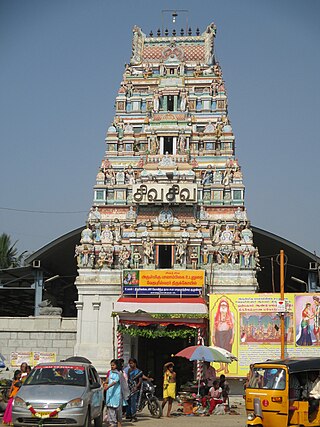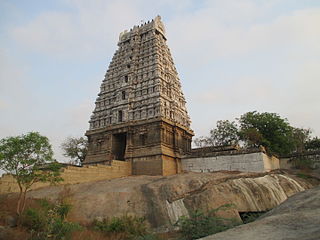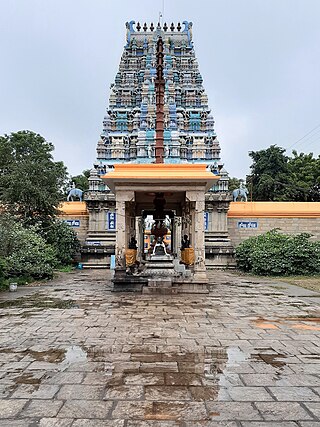
Tiruvalithayam Tiruvallesvarar Temple is a temple dedicated to the Hindu deity Shiva, located at Padi, a north-western neighbourhood of Chennai, India. Shiva is worshiped as Tiruvalleswarar, and is represented by the lingam and his consort Parvati is depicted as Jagadambiga. The presiding deity is revered in the 7th century Tamil Saiva canonical work, the Tevaram, written by Tamil poet saints known as the nayanars and classified as Paadal Petra Sthalam.

Sivayoginathar Temple also known as Yoganandeswarar temple is a Hindu temple dedicated to Shiva located in is located in Thiruvisanallur in Thanjavur district, Tamil Nadu, India. Shiva is worshiped as Sivayoginathar, and is represented by the lingam and his consort Parvati is depicted as Mangala Nayagi. The presiding deity is revered in the 7th century Tamil Saiva canonical work, the Tevaram, written by Tamil poet saints known as the nayanars and classified as Paadal Petra Sthalam.

Sakshinatheswarar Temple or Thiruppurambiyam Temple is a Hindu temple dedicated to the God Shiva located in Thiruppurambiyam, Tamil Nadu, India. Shiva is worshipped as Sakshinathar, and is represented here by a Lingam. His consort, Parvati, is depicted as Ikshuvani. The presiding deity is revered in the 7th century Tamil Saiva canonical work, Thevaram, written by Tamil saint poets, known as the Nayanmaars and classified as Paadal Petra Sthalam.

Pushpavananathar Temple is a Hindu temple dedicated to Shiva located in the village of Tiruppoonturutti near Tiruvaiyaru, Tamil Nadu, India. Shiva is worshiped as Aiyarappar, and is represented by the lingam and his consort Parvati is depicted as Soundaranayagi. The presiding deity is revered in the 7th century Tamil Saiva canonical work, the Tevaram, written by Tamil poet saints known as the nayanars and classified as Paadal Petra Sthalam.

Panchavarnaswamy Temple (பஞ்சவர்ணஸ்வாமி கோயில்) is a Tamil temple dedicated to Shiva, located in Woraiyur, a neighborhood in the town of Tiruchirapalli in Tamil Nadu, India. Shiva is believed to portray five different colours, giving the name of the presiding deity, Panchavarnaswamy. Panchavarnaswamy is revered in the 7th century Tamil Saiva canonical work, the Tevaram, written by Tamil saint poets known as the tri-nayanars (சம்பந்தர், திருநாவுக்கரசர், சுந்தரர், and classified as Paadal Petra Sthalam.

Tiruppaatrurai Adhimooleswarar Temple is a Hindu temple dedicated to Shiva (Adhimooleswarar) located at Tirupattrurai in Trichy district of Tamil Nadu, India. The historical name of the place is Tirupalathurai. The temple is revered in the 7th century Tamil Shaiva canon, the Tevaram, written by the Tamil Nayanar saint-poets and thus classified as Paadal Petra Sthalam.

Anekadhangavadeswarar Temple is a Hindu temple dedicated to Shiva, located in the town of Kanchipuram, near Kailasanathar temple, Kanchipuram district in Tamil Nadu, India. Anekadhangavadeswarar is revered in the 7th century Tamil Saiva canonical work, the Tevaram, written by Tamil saint poets known as the nayanars and classified as Paadal Petra Sthalam, the 275 temples revered in the canon.

Vedapureeswarar Temple is a Hindu temple dedicated to the deity Shiva, located in Thiruverkadu, a Municipality in Tiruvallur district in the South Indian state of Tamil Nadu. Shiva is worshipped as Vedapureeswarar, and is represented by the lingam. His consort Parvati is depicted as Balambigai. The presiding deity is revered in the 7th century Tamil Saiva canonical work, the Tevaram, written by Tamil saint poets known as the Nayanars and classified as Paadal Petra Sthalam.

Kachabeswarar Temple, Thirukachur is a Hindu temple dedicated to the deity Shiva, located in Thirukachur, a village in Kanchipuram district in the South Indian state of Tamil Nadu. Shiva is worshipped as Kachabeswarar, and is represented by the lingam. His consort Parvati is depicted as Antanatchi and Kanniyumaiyal. The presiding deity is revered in the 7th-century CE Tamil Saiva canonical work, the Tevaram, written by Tamil saint poets known as the Nayanars and classified as Paadal Petra Sthalam. The temple is counted as a twin temple along with Marundeeswarar Temple located in the same village.

Atulya Nadheswarar Temple is a Hindu temple dedicated to the deity Shiva, located in Arakandanallur in Thirukoilur taluk, a town panchayat in Viluppuram district in the South Indian state of Tamil Nadu. Shiva is worshipped as Atulya Nadheswarar, and is represented by the lingam. His consort Parvati is depicted as Azhagiya Ponnazhagi. The presiding deity is revered in the 7th century Tamil Saiva canonical work, the Tevaram, written by Tamil saint poets known as the Nayanars and classified as Paadal Petra Sthalam.

Marundeeswarar Temple is a Hindu temple dedicated to the deity Shiva, located in T. Edaiyar, a village in Viluppuram district in the South Indian state of Tamil Nadu. Shiva is worshipped as Marundeeswarar, and is represented by the lingam. His consort Parvati is depicted as Balambigai. The temple is located on the Southern banks of Thenpennai River on the Thirukoilur - Thiruvennainallur road. The presiding deity is revered in the 7th century Tamil Saiva canonical work, the Tevaram, written by Tamil saint poets known as the nayanmars and classified as Paadal Petra Sthalam.

Vaseeswarar Temple is a Hindu temple dedicated to the deity Shiva, located in Thirupasoor, a village in Tiruvallur district in the South Indian state of Tamil Nadu. Shiva is worshiped as Vaseeswarar, and is represented by the lingam. His consort Parvati is depicted as Pasupathinayagi. The temple is located on the Southern banks of Poondi reservoir on the Thiruvallur - Thiruthani road, 5 km (3.1 mi) away from the town. The presiding deity is revered in the 7th-century CE Tamil Saiva canonical work, the Tevaram, written by Tamil saint poets known as the nayanmars and classified as Paadal Petra Sthalam.

Agnipureeswarar Temple in Thirupugalur, a village in Nagapattinam district in the South Indian state of Tamil Nadu, is dedicated to the Hindu god Shiva. Constructed in the Tamil style of architecture, the temple is believed to have been built during the Cholas period in the 10th century. Shiva is worshipped as Agnipureeswarar and his consort Parvathi as Karundar Kuzhali. The temple is believed to be the place where Saiva saint Appar is believed to have attained salvation.

Oondreswarar Temple is a Hindu temple dedicated to the deity Shiva, located in Poondi, a village in Tiruvallur district in the South Indian state of Tamil Nadu. Shiva is worshiped as Oondreswarar, and is represented by the lingam. His consort Parvati is depicted as Minnoli Amman. The temple is located on the Northern banks of Poondi reservoir on the Thiruvallur - Thiruthani road, 11 km (6.8 mi) away from the town. The presiding deity is revered in the 7th-century CE Tamil Saiva canonical work, the Tevaram, written by Tamil saint poets known as the Nayanmars and classified as Paadal Petra Sthalam.

Narthana Vallabeswarar Temple is a Hindu temple dedicated to the deity Shiva, located in Thirukoodalaiyathoor, a village in Cuddalore district in the South Indian state of Tamil Nadu. Shiva is worshipped as Narthana Vallabeswarar, and is represented by the lingam. His consort Parvati is depicted as Gnanasakthi and Parasakthi. The presiding deity is revered in the 7th century Tamil Saiva canonical work, the Tevaram, written by Tamil saint poets known as the Nayanars and classified as Paadal Petra Sthalam.

Jalanatheeswarar Temple is a Hindu temple dedicated to the deity Shiva, located in Thakkolam, a village in Vellore district in the South Indian state of Tamil Nadu. Shiva is worshipped as Jalanatheeswarar, and is represented by the lingam. His consort Parvati is depicted as Giriraja Kannikambal. The presiding deity is revered in the 7th century Tamil Saiva canonical work, the Tevaram, written by Tamil saint poets known as the Nayanars and classified as Paadal Petra Sthalam.

Arasaleeswarar Temple is a Hindu temple dedicated to the deity Shiva, located in Olindiyampattu, a village in Villupuram district in the South Indian state of Tamil Nadu. Shiva is worshipped as Arasaleeswarar, and is represented by the lingam. His consort Parvati is depicted as Periyanaayagi. The presiding deity is revered in the 7th century Tamil Saiva canonical work, the Tevaram, written by Tamil saint poets known as the Nayanars and classified as Paadal Petra Sthalam.

Sivalokanathar temple is a Hindu temple dedicated to the deity Shiva, located in Gramam, a village in Villupuram district in the South Indian state of Tamil Nadu. Shiva is worshiped as Sivalokanathar, and is represented by the lingam. His consort Parvati is depicted as Soundaranayagi. The presiding deity is revered in the 7th century Tamil Saiva canonical work, the Tevaram, written by Tamil saint poets known as the Nayanars and classified as Paadal Petra Sthalam.

Pushpavaneswarar temple in Thirupuvanam, a town in Sivaganga district in the South Indian state of Tamil Nadu, is dedicated to the Hindu god Shiva. Constructed in the Dravidian style of architecture, the temple is believed to have been built during the Cholas period in the 7th century. Shiva is worshipped as Pushpavaneswarar and his consort Parvathi as Soundaranayagi.

The Paraithurainathar Temple is a Hindu temple in the town of Thirupparaithurai, Karur district of Tamil Nadu, India. The presiding deity Paraithurainathar, a form of Shiva, is revered in the Tevaram, written by the Tamil saint-poets known as the Nayanmars. The temple is classified as a Paadal Petra Sthalam. The temple gives its name to the village of Thirupparaithurai.
























